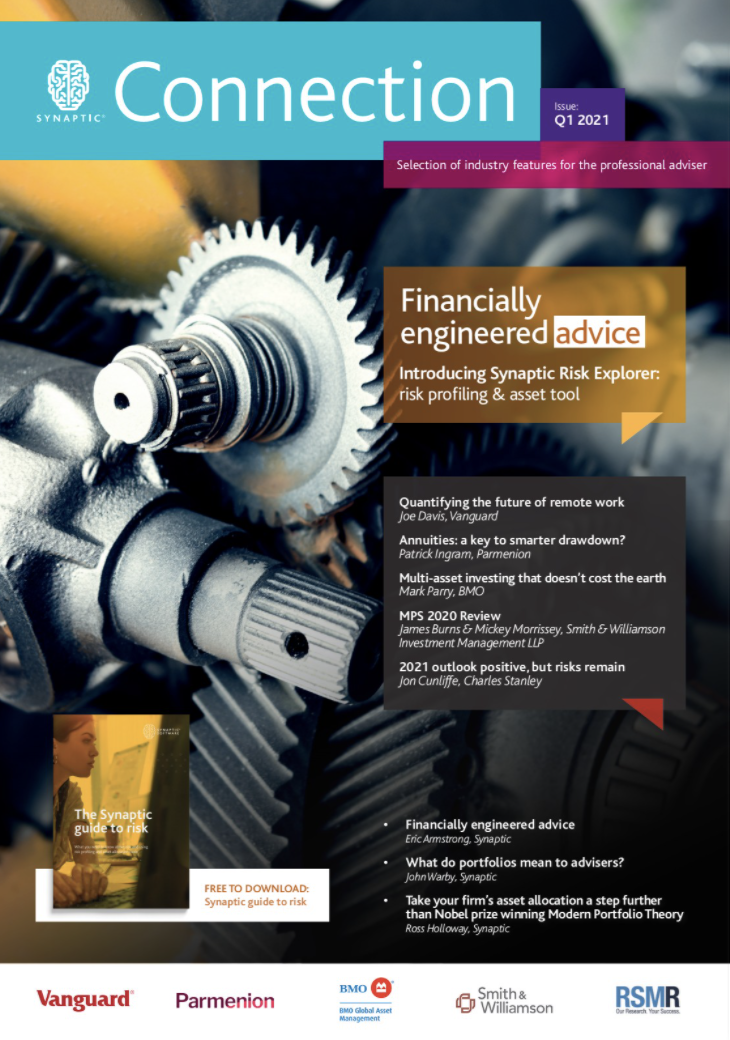In this edition...
- Financially engineered advice now standard Eric Armstrong, Client Director Synaptic Software Limited
- What do portfolios mean to advisers? John Warby, Senior Business Relationship Manager Synaptic Software Limited
- Take your firm’s asset allocation a step further than Nobel prize winning Modern Portfolio Theory Ross Holloway, Business Development Manager Synaptic Software Limited
- Risk Explorer infographic Editorial team, Synaptic Software Limited
- Quantifying the future of remote work Joe Davis, Global Chief Economist Vanguard
- Annuities: a key to smarter drawdown? Patrick Ingram, Head of Strategic Partnerships Parmenion
- Multi-asset investing that doesn’t cost the earth Mark Parry, Director, Head of Strategic and Technical Sales BMO
- MPS 2020 Review James Burns, Partner Smith & Williamson Investment Management LLP
- 2021 outlook positive, but risks remain Jon Cunliffe, Chief Investment Officer Charles Stanley
- The Chinese consumer revolution Janet Mui, Investment Director Brewin Dolphin
- EEE ESS GEE: The Sequel Steve Nelson, Head of research the lang cat
- Drivers and developments in sustainable multi-asset investing Maria Municchi, Fund Manager, Sustainable Multi Asset Fund Range M&G Investments
- RSMR Weekly Broadcast: the battle for content – deal or no deal? Richard O’Sullivan, Investment Research Manager RSMR
- COVID-19: Bringing operational financial strength into sharper focus Guy Vanner, Managing Director AKG
- Video - every adviser’s new best friend Martyn Pask, Director Asset TV

Despite global economic growth entering another pandemic-driven soft patch, we are constructive on equities over the next few months.
Growth will accelerate as we head into the second quarter. Inflation will rise, but not to the extent that major central banks will alter their monetary policy which will remain highly accommodative.
A Democrat-controlled US Congress increases the likelihood of a more-aggressive US stimulus package, including significant investment in clean energy as part of a green-infrastructure programme.
This type of macroeconomic and policy environment is strongly reflationary, evidenced by rising market-implied inflation rates and a steeper US yield curve, a weaker US Dollar and stronger commodity prices. Assets which are cyclical often perform strongly in this type of environment.
Against this backdrop, while we still like the US market, we have recently tempered our outlook in favour of Asia, which benefits from a better growth dynamic and more generous valuations – whilst still affording access to tech exposure.
We also expect the UK and Eurozone markets to fare better, due to the higher weight they have in cyclical sectors – banks, energy, materials and industrials – some of which were hit hard by Covid-19 restrictions.
Responsible and Sustainable Investing took centre stage in 2020 and we expect both opportunities and threats to continue to emerge. There is now a range of good-performing green investment funds available, while a lot of traditional industries – notably big oil and automobiles – are likely to face costly write downs of capital investment.
As a result, our enthusiasm for cyclical assets in the months ahead needs to be viewed in the context of these longer-term headwinds to traditional sectors of the economy.
There are several risks to our constructive view on equities and cyclical assets. The rollout of vaccines could take longer than expected, or their effectiveness may prove to be lower in the wider population than indicated in trials. Write-downs and the permanent loss of capacity in damaged sectors could prove to be a bigger drag on the economic recovery than anticipated.
Fiscal policy could be tightened prematurely – as governments lose their nerve – causing the recovery to fade and corporate profits to disappoint.
Our base case is for global equities to deliver a high-single-digit return over 2021, with the bulk of these gains in the first half of the year.
Looking to the future, assets that produce a relatively generous and reliable income stream will continue to command a premium.
Infrastructure investments may be more attractive over the longer term as well as equities with fixed-income type characteristics requiring a more imaginative approach to strategic-asset allocation.
Our Blended Managed Portfolio Solution:
Within our Blended MPS solution, we take our central research insights and rigorous investment process and apply them in a flexible way to our Blended MPS portfolios, which offer a globally diversified, actively managed solution and are run on a discretionary basis. We are not tied to using one investment philosophy or one investment vehicle structure. We choose the best method of implementing our investment ideas in order to try and generate the best risk-adjusted returns possible for our clients. The Charles Stanley Blended MPS solution is now risk rated by Synaptic.
Given our inflation plus investment targets, we start our portfolio construction process from a blank sheet rather than taking a market index or asset allocation from external sources. There is no "home-bias" to our investment approach and therefore we invest freely across the globe. The most obvious example of this is the small weight allocated to the domestic UK equity market, at approximately 5% of portfolios currently, even with this being held within a 0% AMC share class of the Charles Stanley Equity Fund managed by the same team.
This flexible approach removes the need for the active vs passive debate, as we buy active managers where we think there is consistent and achievable alpha to be captured, and if not then we take on targeted market beta through passive vehicles. In the context of our current allocations, this translates to approximately two thirds passive vehicles and one third active. This split will flex through the economic cycle as we look at the environment we find ourselves in and the opportunities available. Generally speaking, we see more scope for active managers within areas such as Emerging Markets, Asia Pacific, High Yield Bonds and Infrastructure, than developed market equities like the US.
The lion's share of our returns last year, as in many recent years, came from our North American Equity exposure – particularly positions like the Invesco Nasdaq-100 ETF. This was however, complemented by our second largest equity exposures to Emerging Markets, focussed on Emerging Asia. As we enter 2021, we anticipate these regions to continue outperforming. We have composed this exposure via Stewart Asia Pacific Sustainability, Schroder Asian Total Return and JPM Emerging Markets funds. Each of these funds warrant inclusion on a standalone basis, but importantly they also aggregate well together to give a blended exposure to the regions.
We take a managed approach to our fixed income exposure rather than outsourcing too much to strategic bond funds. We benefitted last year from targeting sovereign debt, particularly from the US where there was more yield compression possible. We recently trimmed some of these positions as we look to manage our duration and credit exposures in a very dynamic market environment. These themes are primarily implemented through targeted passive vehicles focusing on a market segment or maturity profile.
In keeping with our "go anywhere" approach, we retain the ability to buy Investment Trusts where we consider them to be appropriate. Infrastructure assets are inherently long duration assets, often with forecastable revenue streams and inflation linkage to them. We currently hold two trusts in this space, International Public Partnerships (INPP) and The Renewable Infrastructure Group (TRIG). The former invests in public or social infrastructure assets and the latter those generating renewable energy. Crucially, the investment vehicle structure matches the liquidity profile of the underlying investments.

Source: Financial Express Analytics at 31/12/20. Total Return, Sterling, bid-to-bid, net of ongoing charges and Charles Stanley's Annual Management Charge but excluding any platform or IFA charges. Net income reinvested. Inception: 31st August 2018.
Meet the Manager:

Chris Ainscough
Director of Asset Management,
Charles Stanley
Chris joined Charles Stanley in 2014 and has worked across both our actively and passively implemented strategies. He now heads up our structure agnostic solutions, including the Blended MPS and Charles Stanley Multi Asset OEICs, where he invests across a broad investment universe from direct equity and fixed income through to active and passive collective vehicles. Chris takes an unconstrained approach to investing, in terms of both securities used to implement an investment theme and the geographies/sectors contained in the investment universe. He is supported by the Asset Management and Research Teams, with a centralised and collegiate approach to investment management.
Contact us to find out more about our Managed Portfolio Services and how they could enhance your offering.
charles-stanley.co.uk/professional-adviser-services
The value of investments can fall as well as rise. Investors may get back less than invested. Past performance is not a reliable guide to future returns. Charles Stanley & Co. Limited is authorised and regulate by the Financial Conduct Authority.
Sign up for updates
Keep up to speed with everything you need to know each quarter, by email or post.


